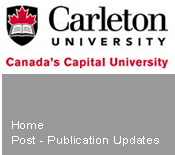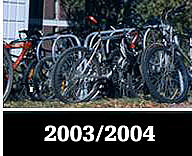



| Admissions | Regulations | Programs | Courses | Officers | The University |
| The Academic Year |
| Electronic Access to the Undergraduate Calendar |
| Accreditation of the University |
| Disclosure |
| Copyright Compliance |
| Fees |
| Selected Senate Policies |
| Map |
 |
 |
 |
 |
|
|
General Admission Requirements and Procedures (cont'd)5. Dates of EntryStudents may be admitted to register in January, May and July as well as in September. (See the Academic Year section of this Calendar.) It should be noted however, that a full range of courses is only offered during the fall/winter session, i.e. September to May. 6. Levels of EntryWhen a student is admitted at the first-year level, the degree program is normally four years for an Honours degree and three years for a General degree with a normal course load. Beyond first year, remaining degree requirements are determined by the total number of credits required for that particular degree program less those credits granted on transfer from previous post-secondary studies. 7. Concurrent StudiesThe Concurrent Studies program enables Secondary School students to begin University-level study while completing any outstanding requirements for their high school diploma. The availability of the Concurrent Studies program will be of particular interest to those students in semestered schools who are not taking a full load of high school credits in their final year of study. Students in non-semestered high schools may also wish to take advantage of this opportunity in their final year if they are not taking a full credit load. Students who wish to take advantage of the Concurrent Studies program will register as Special students. Special students may normally enrol in a maximum of 1.0 credit in each of the fall term, winter term and summer session. With admission to a degree program, program requirements for a degree will be reduced by the number of credits successfully completed as part of the Concurrent Studies program that are appropriate to the degree. Other universities normally grant credit on admission for courses taken at Carleton as a Special student. 8. Admission to Certificate and Diploma ProgramsIn addition to offering seventeen undergraduate degree programs, for which the admission requi rements are stated on the following pages,Carleton offers six certificate programs and one diploma program Please refer to the "Summary of Admi ssi on Requi rements" for additional information. 9. High School ApplicantsOntario
The overall admission average and mix of OACs or grade 12 4U/4M courses required is dependent upon the degree or program for which the student is applying. Detailed admission requirements for each undergraduate degree program can be found in the "Summary of Admission Requirements" following this section. Holding the minimum admission requirements only establishes eligibility for consideration to Carleton University programs. Admission averages and required marks will vary from year to year and will be determined by the availability of places and by the number of applicants. The overall admission average may be higher than the stated minimum requirements. Students who feel that their high school grade average does not reflect their potential are encouraged to apply to the Enriched Support Program. For more information, see the Enriched Support Program information following the Admissions section of this Calendar. Carleton University uses, for admission purposes,the credit system as defined by the Ministry of Education, Universities and Colleges. In calculating averages, the weighting factor assigned to a subject will be directly proportional to the credit value of that subject. Quebec Other Canadian Provinces From the Canadian provinces and territories whose pre-university studies culminate in 12 years of schooling, graduates are considered for direct admission into first year. At the present time, graduates from high schools in the following provinces and territories are considered for admission. The overall average required is dependent upon the degree or program for which the students are applying. Alberta It is recognized that the curriculum of some provinces does not include an introductory course in calculus, or that a final-year mathematics course may have only a few weeks of an introduction to calculus, or that only a few schools in a particular province or territory may offer a calculus course to a selected group of students. In instances where no calculus is presented, and there is a requirement for it in the University program to which the student is admitted, adjustments may have to be made to include Mathematics MATH 0007 (69.007*) (Introductory Calculus) as an extra half credit beyond the normal degree program requirements. It is recognized that the curriculum of some provinces does not include an equivalent to Algebra/Geometry or Geometry and Discrete Mathematics.In instances where no equivalent is presented, and there is a requirement for it in the University program to which the student is admitted, adjustments may have to be made to include Mathematics MATH 0107 (69.017*) (Algebra and Geometry) . In some degree programs, this will be an extra half credit beyond the normal degree requirements. It shoul d be noted that for some restri cted-enrol ment programs, preference may be given to applicants who, along with a high academic standing, have completed an introductory course in calculus. The United States
Advanced Placement International Baccalaureate Other High School Systems Generally speaking, such applicants must meet requirements for admission to a university in their own country. The following certificates may be accepted to meet admission requirements to first year: United Kingdom, West Indies, East and West Africa, Hong Kong: The General Certificate of Education (or the equivalent) with satisfactory standing in five subjects at Ordinary Level (or equivalent) and two suitable subjects at Advanced Level. International: The International Baccalaureate. 10. Special Requirements for Overseas StudentsTranslation of Documents
|
||||||||||||||||||||||||
|
©Carleton University 1125
Colonel By Drive, Ottawa, Ontario K1S 5B6 Canada |
||